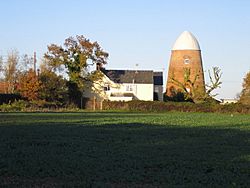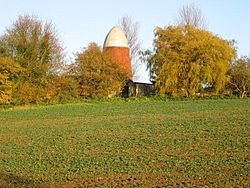Clavering Windmills facts for kids
Quick facts for kids North Mill, Clavering |
|
|---|---|

North Mill, November 2006
|
|
| Origin | |
| Mill name | North Mill |
| Grid reference | TL 466 328 |
| Coordinates | 51°58′26″N 0°08′10″E / 51.974°N 0.136°E |
| Operator(s) | Private |
| Year built | 1811 |
| Information | |
| Purpose | Corn mill |
| Type | Tower mill |
| Storeys | Five storeys |
| No. of sails | Four sails |
| Type of sails | Single Patent sails |
| Auxiliary power | Oil engine |
| No. of pairs of millstones | Three pairs |
| South Mill, Clavering | |
|---|---|

South Mill, November 2006
|
|
| Origin | |
| Mill name | South Mill |
| Grid reference | TL 465 326 |
| Coordinates | 51°58′23″N 0°07′59″E / 51.973°N 0.133°E |
| Operator(s) | Private |
| Year built | 1757 |
| Information | |
| Purpose | Corn mill |
| Type | Tower mill |
| Storeys | Four storeys |
| No. of sails | Four sails |
| Type of sails | Spring sails |
| Winding | Fantail |
| No. of pairs of millstones | Two pairs |
The Clavering Windmills are two old windmills in Clavering, Essex, England. They are called North Mill and South Mill. Both are Grade II listed buildings. This means they are important historical structures. Today, they are no longer used for grinding corn. Instead, they have been turned into homes. A third mill, called Clavering Mill, also existed here long ago.
Contents
History of Clavering Windmills
The Old Clavering Mill
The first mill in Clavering was a Post mill. This type of windmill has a large wooden body that can turn to face the wind. Maps from the 1600s show this mill. It was owned by important families like the Barringtons. The mill was still working in 1848. After this date, it is thought to have been taken down.
North Mill's Story
North Mill was built in 1811 by James Pavitt. It worked alongside the old post mill for many years. Around 1919, an oil engine was added to help grind corn. This engine was quite powerful, at 16 horsepower. The mill's sails were removed around this time. The engine kept the mill working for a long time.
South Mill's Story
South Mill is even older, built in 1757. It stopped working for a while around 1906. But then, a new owner, William Caton, got it running again. It used wind power until 1919. The sails were taken off the next year. This mill never had an engine. It relied only on the wind to work.
How the Mills Worked
North Mill's Design
North Mill is a Tower mill. This means it has a tall, round stone tower. It has five floors inside. The top part, called a beehive cap, could turn to catch the wind. A special fan, called a fantail, helped turn the cap. It had four large sails that spun clockwise. Inside, a wooden shaft and a big gear wheel helped power three pairs of millstones. These stones ground the corn.
South Mill's Design
South Mill is also a tower mill. It has four floors and a beehive cap, just like North Mill. It also had a fantail to turn its cap. This mill used four "Single Spring sails." These sails had springs to help them adjust to the wind. Inside, it powered two pairs of French Burr millstones. These were special stones used for grinding.
People Who Ran the Mills (Millers)
Many people worked hard to run these windmills over the years. Here are some of the millers:
Clavering Mill (Post Mill) Millers
- William Hill (1702)
- Thomas Nottage (1802)
- James Pavitt (1804 - 1845)
South Mill Millers
- Henry Salmon (1772 - 1804)
- Henry Moore (1840–1850)
- William Overill (1849)
- Zachariah Livings (1861)
- Robert Spencer (1871)
- William Caton (1906 - 1919)
North Mill Millers
- James Pavitt (1811–1845)
- James Pavitt Jr (1845 - 1850)
- Spencer (1879)
- William Caton (1906 – )
- A E Caton (1935)

